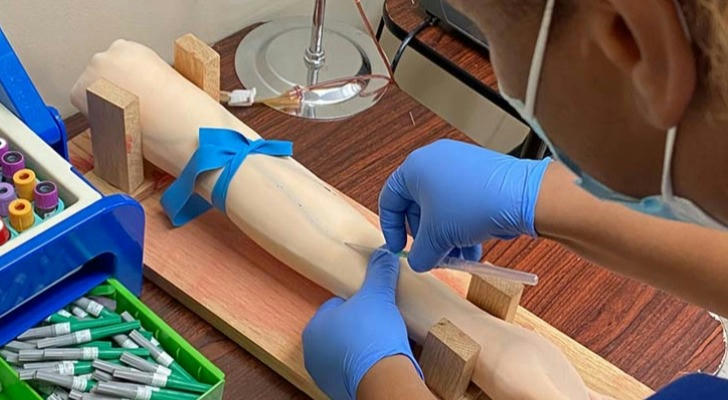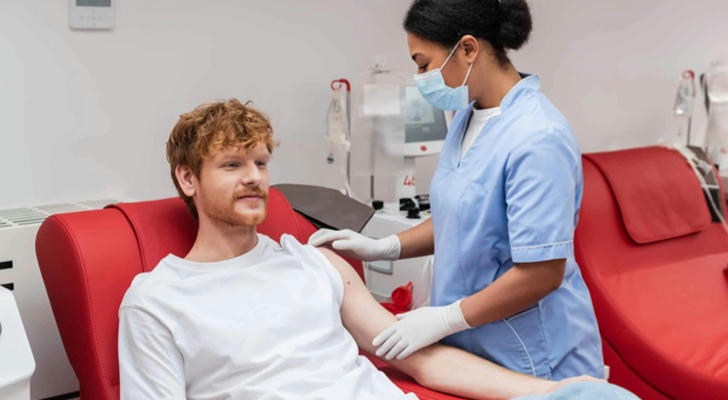Phlebotomist: A Fast and Rewarding Career Path in the U.S. Healthcare Industry
Article Keyword Guide: Phlebotomy training, phlebotomy certification, healthcare career, high-demand jobs, government financial aid, medical technician jobs
The first part of this article will provide you with a quick overview of the phlebotomy profession, phlebotomy course registration, and phlebotomy career pathways. If you are interested in this career and would like to learn more, scroll down for a detailed introduction. In the full article, we will dive deeper into the industry, providing in-depth information to help you make an informed decision.
• U.S. Bureau of Labor Statistics (BLS): Over the next seven years, the demand for phlebotomists is expected to outpace many other professions.
• Certification Process: Can be completed in as little as four months.
• Tuition Assistance: Multiple government funding programs are available.
• Salary Expectations: According to the U.S. Department of Labor, as of May 2023, the average annual salary for phlebotomists is $41,810.
• Career Prospects: Further education can lead to advanced healthcare roles, higher salaries, and management opportunities.
Find More Phlebotomy Courses
We have prepared some search results for you through Google's powerful network system.Please note that: Phlebotomy courses and the phlebotomy profession belong to academic and technical fields, requiring hands-on practice to master the necessary skills. Online courses can help deepen your understanding of phlebotomy concepts alongside practical training. However, solely completing an online course does not lead to certification or employment opportunities.
For this reason, phlebotomy courses are typically paid programs. It is important to be cautious and distinguish exaggerated promotional claims.
Below is our in-depth analysis of the phlebotomy industry
Are you looking for a stable and well-paying job in the healthcare industry without spending years in school? Becoming a phlebotomist might be the perfect option for you. With high demand, short training periods, and government-supported financial aid, this career offers a quick and affordable way to enter the medical field. Whether you are a newcomer, a career changer, or someone seeking a reliable job with opportunities for growth, phlebotomy can be an excellent choice.

This article will explore the role of a phlebotomist, job market demand, certification requirements, training duration, government support, and career growth opportunities. By the end, you'll have a clear understanding of why phlebotomy is one of the fastest-growing healthcare careers in the U.S.
1. What Does a Phlebotomist Do?
A phlebotomist is a trained medical professional responsible for drawing blood from patients for laboratory testing, transfusions, donations, or research. Their daily tasks include:
Identifying patients and verifying their information before collecting samples
Using sterile techniques to draw blood safely and efficiently
Labeling and handling blood samples for accurate testing
Assisting patients who may feel anxious or fearful about the procedure
Ensuring compliance with health and safety regulations to prevent infections
Phlebotomists typically work in hospitals, diagnostic laboratories, blood donation centers, and physician’s offices, making this a versatile career choice with diverse work settings.
2. High Demand and Job Market Growth
The U.S. Bureau of Labor Statistics (BLS) reports that employment for phlebotomists is expected to grow by 8% from 2022 to 2032, faster than the average for many other professions. This high demand is driven by:
✅ An aging population requiring more medical tests
✅ An increase in chronic diseases such as diabetes and cardiovascular conditions
✅ More frequent blood tests for preventive healthcare
With over 21,000 job openings projected each year, phlebotomists enjoy excellent job security and stable employment opportunities across the U.S.
3. Quick and Easy Certification Process
One of the biggest advantages of becoming a phlebotomist is the short training period. Unlike other healthcare professions that require years of schooling, phlebotomy certification can be obtained in as little as 4-8 months.
To become a certified phlebotomist, you typically need to:
1.Complete a state-approved phlebotomy training program (4-8 months)
2.Gain hands-on clinical experience through internships or externships
3.Pass a national certification exam

Recognized Certification Bodies
Several organizations offer national certification for phlebotomists, including:
National Healthcareer Association (NHA) – Certified Phlebotomy Technician (CPT)
American Society for Clinical Pathology (ASCP) – Phlebotomy Technician (PBT-ASCP)
American Medical Technologists (AMT) – Registered Phlebotomy Technician (RPT-AMT)
National Center for Competency Testing (NCCT) – National Certified Phlebotomy Technician (NCPT)
Some states, such as California and Louisiana, require additional licensing, but most states only require national certification, making it easy to start your career.
4. Government Support and Financial Aid
For individuals concerned about training costs, the U.S. government provides financial assistance to help students afford phlebotomy programs. Some common funding options include:
Pell Grants – Need-based financial aid for low-income students
Workforce Innovation and Opportunity Act (WIOA) Funding – Covers training costs for high-demand jobs like phlebotomy
GI Bill Benefits – Available for military veterans and their families
State and Local Grants – Many states offer funding for healthcare training programs
Some employers, such as hospitals and diagnostic labs, may even cover training costs for new hires or offer tuition reimbursement programs.
5. Salary and Career Growth Opportunities
Phlebotomists earn competitive salaries, with the potential to increase earnings as they gain experience. The average salaries in different states are:
National Average: $38,530 per year ($18.53 per hour)
Entry-Level: $30,000 per year
Experienced Phlebotomists: $50,000+ per year
Specialized Roles (Hospital or Research Labs): Up to $60,000 per year
Many phlebotomists advance their careers by pursuing further education and certifications, leading to positions such as:
Medical Lab Technician – Higher salary, responsible for analyzing blood samples
Registered Nurse (RN) – With additional schooling, phlebotomists can transition into nursing
Healthcare Administration – Moving into lab management or hospital administration roles
6. Success Stories: How Fast Can You Get a Job?
✅ Case Study 1: John’s Quick Career Change
John was working in retail when he decided to switch to the medical field. He completed a 6-month phlebotomy program, obtained his certification through NHA, and was hired at a hospital within 2 months of graduation. He now earns $22 per hour and plans to advance into laboratory technology.
✅ Case Study 2: Maria’s Path as a New Immigrant
Maria, a recent immigrant, struggled to find a job due to language barriers. She enrolled in a government-sponsored phlebotomy course, which covered her tuition costs. After completing her 8-month training, she passed the ASCP exam and secured a full-time position at a blood donation center earning $3,500 per month.

Final Thoughts: Why Choose Phlebotomy?
Becoming a phlebotomist is one of the fastest and most affordable ways to enter the U.S. healthcare industry. It offers:
✔ Short training duration (4-8 months)
✔ High job demand and employment security
✔ Government financial aid to reduce training costs
✔ Competitive salaries with career advancement options
If you're looking for a stable, rewarding, and well-paying healthcare career, phlebotomy is an excellent choice. Start your journey today by enrolling in a certified program and obtaining your national certification!
